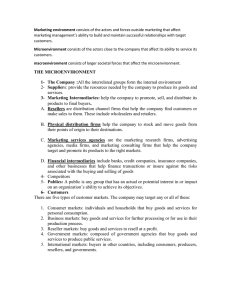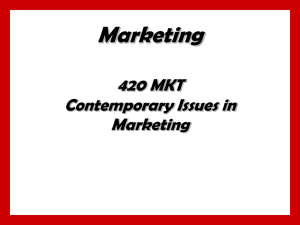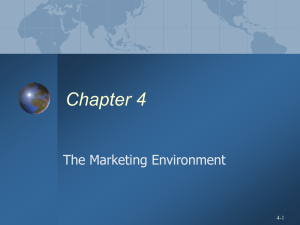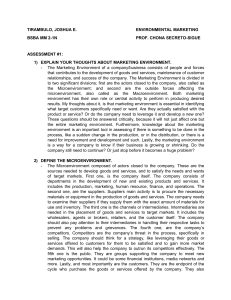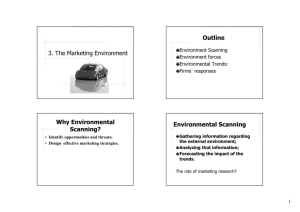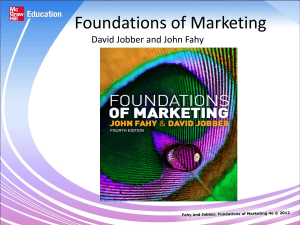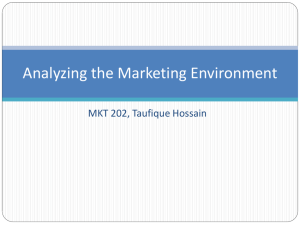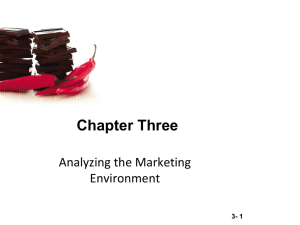L_3_Marketing_Environment
advertisement
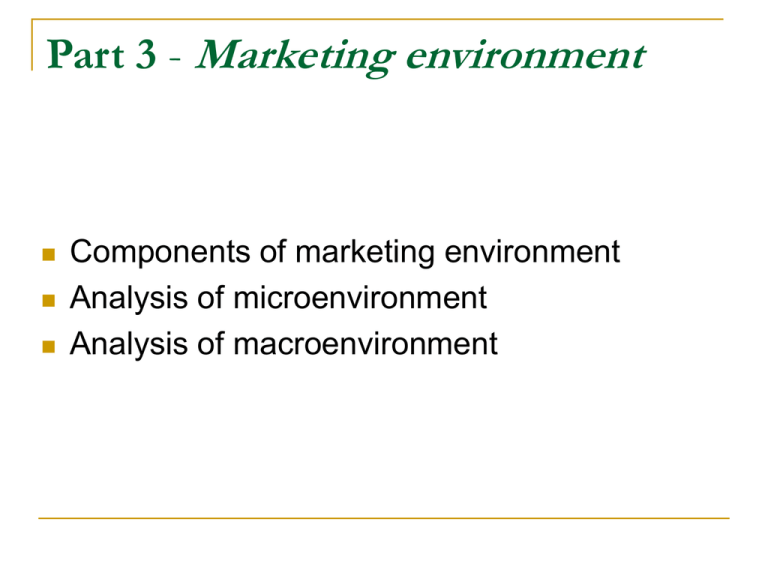
Part 3 - Marketing environment Components of marketing environment Analysis of microenvironment Analysis of macroenvironment Marketing Environment Includes: Microenvironment: actors close to the company that affect its ability to serve its customers. Controled of the organization Macroenvironment: larger societal forces that affect the microenvironment. Considered to be beyond the control of the organization (= bad & good news ) Actors in the Microenvironment The Company’s Microenvironment Suppliers: Provide resources needed to produce goods and services. Important link in the “value delivery system.” Most marketers treat suppliers like partners. The Company’s Microenvironment Marketing Intermediaries: Help the company to promote, sell, and distribute its goods to final buyers Resellers (incl. wholesalers and retailers,…) Physical distribution /logistics firms (forwarding/shipping) Marketing services agencies Financial intermediaries Partnering With Intermediaries Five Types of Customers Consumer markets Business markets (B to B) Reseller markets Government markets International markets Competitors Must understand competitor’s strengths Must differentiate firm’s products and offerings from those of competitors Competitive strategies should emphasize firm’s distinctive competitive advantage in marketplace Types of Publics The Macroenvironment The company and all of the other actors operate in a larger macroenvironment of forces that shape opportunities and pose threats to the company. Case study: McDonald´s in Moscow – good understanding of the environment Opened in 1990 Dealt with the situation in Russia Training for all staff Raw materials adjusted to Russia (wheat, milk) No repatriation of profits (investment in R) Menus tailored to customers tastes Major areas of the external market environment 4-7 Demographic environment Economic environment Technological environment Political and legal environment Cultural and social environment Natural environment 1) Demographic environment Birth/death rate/grow of population Age structure Minorities/ethnic markets Rural/urban inhabitation/migration Types of households Education SNB sings about € Demographic development 4-7 Demographic development II Birth rate curve in the Czech Republic 4-7 2) Economic Factors Inflation Employment Business cycles Energy availability and cost Disposable income/distribution of incomes Savings/loans Real Income in CZ 4-7 The Economic and Technological Environment Global Economy Rapid Change Key Economic Forces Interest and exchange Rates 4-7 3) Political/legal Monopolies legislation Environmental protection laws Taxation policy Employment laws Government policy Legislation Legal Regulation Covers Companies vs society Companies vs companies Companies vs customers - „Consumer protection policy 2006 - 2010" (including ecommerce trading, non-court settlements, personal data protection,… 4) Technological New discoveries and innovations Speed of technology transfer Rates of obsolescence Internet Information technology The Impact of Technology Technology is the application of science to convert and economy’s resources to output Technology impacts marketing both through opportunities for new products and new ways (processes) for handling marketing functions Example: consider the Internet Products: software for computer users Process: selling from a web site 4-8 Technology development Curve of invention x marketing curve 5) The Economic vs Natural vs Technological Environment 4-7 6) Sociocultural factors Perception of people (relation to others, relations to the society,…) Culture values/subcultures Religion Social mobility Lifestyle changes The Cultural and Social Environment Time Poverty Economic Power Career Opportunity Cultural Trend: The Changing Roles of Women The Cultural and Social Environment Czechs interested in healthy food and foodstuffs easy to be prepared 2006 change in percent compared to 2003 Children diet +9 Baby formulas and milk + 13 Vine + 10 Beer +3 Frozen foodstuffs +2 Pizza +8 Soft drinks non-sparkling + 21 Energy and sports drinks + 15 Candys and crisps +1 Cereal and müsli bars + 10 Source: AC Nielsen Cultural Environment: „time dimension“
